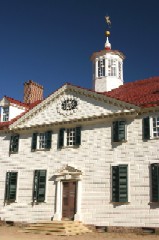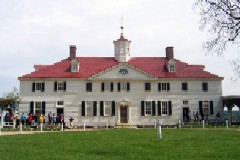Interesting Facts about George Washington’s Mount Vernon
Locations Trivia The property where Mount Vernon, the home of first United States President George Washington, sits was first obtained by John Washington, the great grandfather of George, in 1674. When Washington inherited the estate after the death of his elder half brother, Mount Vernon would rise to great prestige to become one of the most treasured homes in the country. The following article offers a wide array of facts and trivia about this great U.S. landmark.
The property where Mount Vernon, the home of first United States President George Washington, sits was first obtained by John Washington, the great grandfather of George, in 1674. When Washington inherited the estate after the death of his elder half brother, Mount Vernon would rise to great prestige to become one of the most treasured homes in the country. The following article offers a wide array of facts and trivia about this great U.S. landmark.
Mount Vernon is located in Virginia; it overlooks the Potomac River as well as the low hills of Maryland. It is considered to be America’s “first home.”
George Washington’s great grandfather John Washington was granted five thousand acres from King Charles II with the stipulation that he pay an annual rent and “seat and plant” the land within the span of three years. This tract of land was divided with John Spencer.
Before the estate became known as Mount Vernon it was called Hunting Creek Plantation. Much of the early history of the plantation has been gathered from legal documents such as deeds and wills.
Under George Washington’s ownership, the estate was expanded from 2,126 acres to above eight thousand.
Like other eighteenth century plantations, the estate boasted an array of beautiful gardens, a greenhouse and a kitchen garden.
The mansion is considered an excellent example of colonial architecture. The home’s high-columned piazza is considered the standout feature of the mansion. It extends the entire length of the house.
The cupola, another notable feature of the mansion, was added in 1778. Washington added his “dove of peace” weathervane in 1787.
The Banquet Hall contains an engraving of Louis XVI, Sheraton side chairs, and a moonlight river scene above an exquisite mantel. This room was where Washington received the news that he had been elected to the Presidency.
The Central Hall contains a key to Paris’ infamous Bastille-a present from General Lafayette in 1790.
The mansion’s Little Parlor boasts an elegant harpsichord and was the room where the family enjoyed music together.
The West Parlor contains the family’s Coat-of-Arms. This room dates from Washington’s first enlargement of the mansion. It also contains two portraits of Washington and his wife Martha.
The family dining room today contains a mahogany dining table that is believed to have belonged to Martha’s daughter Nelly Custis Lewis.
The second floor of the mansion contains five bed chambers. Historians believe the mansion was continually peopled by family and guests putting a strain on the accommodations. Mrs. Washington arranged low beds in the bedrooms to accommodate extra guests.
After her husband died, Martha Washington closed the master bedroom and resided in a garret bedroom across from her grandson’s bedroom.
The library contains a Mount Vernon original-a terrestrial globe. The room also contains busts of George Washington and John Paul Jones. At the time of Washington’s death, the library contained 884 bound books. Washington considered this room his private sanctuary. After the Revolutionary War the library could not be visited without an invitation from Washington.
Historians have found that although the plantation produced a profit, it did not leave Washington a wealthy man. He did not have an extensive income as much of the plantation’s yield supported the estate. His service to his country prevented him from acquiring the wealth he might otherwise have.
The Washingtons of Mount Vernon were revered for their simple hospitality. Washington said, “A glass of wine and a bit of mutton are always ready, and such as will be content to partake of them are always welcome.”
 During his presidency Washington was only able to visit Mount Vernon fifteen times. Washington died in 1799. The terms of his will stipulated that the estate was not to be divided until after the death of his wife Martha. She died in 1802.
During his presidency Washington was only able to visit Mount Vernon fifteen times. Washington died in 1799. The terms of his will stipulated that the estate was not to be divided until after the death of his wife Martha. She died in 1802.
The home also contains stables, tomb, colonnade, various outbuildings such as the kitchen (off the courtyard) and store rooms.
Washington left the mansion house to his nephew Bushrod Washington. The rest of the estate was divided amongst other relatives.
Interestingly, the estate has been preserved by the nation’s first women’s patriotic organization founded by Miss Pamela Cunningham of South Carolina in 1858 and called the Mount Vernon Ladies’ Association.
